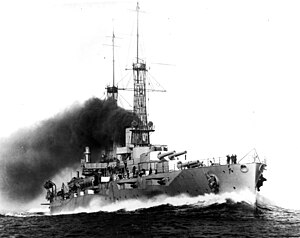
Back Ню Йорк (линеен кораб, 1912) Bulgarian USS New York (BB-34) Czech USS New York (BB-34) German USS New York (BB-34) Spanish USS New York (BB-34) Finnish USS New York (BB-34) French ניו יורק (BB-34) HE USS New York (BB-34) Italian ニューヨーク (戦艦) Japanese USS New York (BB-34) Malay

 New York shortly after entering service in 1915
| |
| History | |
|---|---|
| Name | New York |
| Namesake | State of New York |
| Awarded | 1 May 1911 |
| Builder | Brooklyn Navy Yard |
| Laid down | 11 September 1911 |
| Launched | 30 October 1912 |
| Commissioned | 15 May 1914 |
| Decommissioned | 29 August 1946 |
| Stricken | 13 July 1948 |
| Identification | Hull symbol: BB-34 |
| Honors and awards | |
| Fate | Sunk as a target ship, 1948 |
| General characteristics [1] | |
| Class and type | New York-class battleship |
| Displacement | |
| Length | |
| Beam | 95 ft 2.5 in (29 m) |
| Draft |
|
| Installed power |
|
| Propulsion |
|
| Speed | 21 knots (39 km/h; 24 mph) |
| Range | 7,060 nmi (13,075 km; 8,125 mi) at 10 knots (19 km/h; 12 mph) |
| Complement | 1,042 officers and men |
| Armament |
|
| Armor | |
| General characteristics (1925–1926 refit) | |
| Displacement |
|
| Draft | 31 ft 6 in (9.60 m) (max) |
| Installed power | 6 × Bureau Express water-tube boilers |
| Armament |
|
| Aircraft carried | 3 × floatplanes |
| Aviation facilities | 1 × catapult |
| General characteristics (1942 refit) | |
| Armament |
|
USS New York (BB-34) was a United States Navy battleship, the lead ship of her class. Named for New York State, she was designed as the first ship to carry the 14-inch (356 mm)/45-caliber gun.
Entering service in 1914, she was part of the U.S. Navy force which was sent to reinforce the British Grand Fleet in the North Sea near the end of World War I. During that time, she was involved in at least two incidents with German U-boats, and is believed to have been the only US ship to have sunk one in the war, during an accidental collision in October 1918. Following the war, she was sent on a series of training exercises and cruises in both the Atlantic and the Pacific, and saw several overhauls to increase her armament, aircraft handling and armor.
She entered the Neutrality Patrol at the beginning of World War II, and served as a convoy escort for ships to Iceland and Great Britain in the early phase of the war. She saw her first combat against coastal artillery during Operation Torch around Casablanca in North Africa, and later became a training ship. Late in the war, she moved to the Pacific, and provided naval gunfire support for the invasion of Iwo Jima and later the invasion of Okinawa. Returning to Pearl Harbor for repairs until the end of the war, she was classified obsolete and was chosen to take part in the Operation Crossroads nuclear weapon tests at Bikini Atoll in 1946. She survived both explosions, and the effects of radiation on the ship were studied for two years. She was eventually sunk as a target in 1948. She received three battle stars for her service.
- ^ Gardiner & Gray 1985, p. 115.